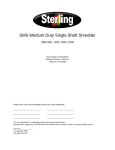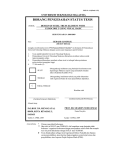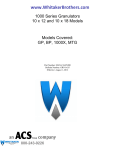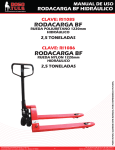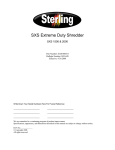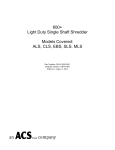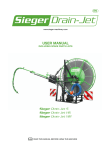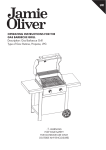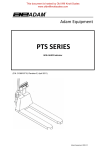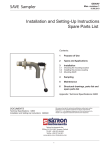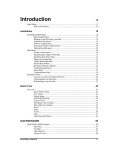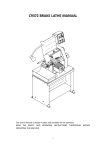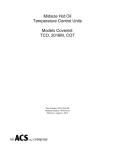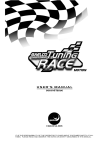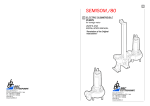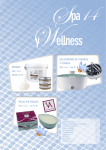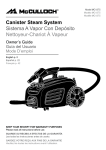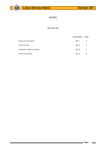Download User Manual
Transcript
www.WhitakerBrothers.com 850,1200, 1500, 2000 Medium Duty Single Shaft Shredder Models Covered: AMS, CMS, SMS, ESS, MMS Part Number: MAN-EPS-0001 Bulletin Number: GRN4-605 Effective: August 1, 2012 Write Down Your Serial Numbers Here For Future Reference: _________________________ _________________________ _________________________ _________________________ _________________________ _________________________ We are committed to a continuing program of product improvement. Specifications, appearance, and dimensions described in this manual are subject to change without notice. DCN No. ____________ © Copyright 2013 All rights reserved. BJ5-615 ii Shipping Info Unpacking and Inspection You should inspect your equipment for possible shipping damage. Thoroughly check the equipment for any damage that might have occurred in transit, such as broken or loose wiring and components, loose hardware and mounting screws, etc. In the Event of Shipping Damage According to the contract terms and conditions of the Carrier, the responsibility of the Shipper ends at the time and place of shipment. Notify the transportation company’s local agent if you discover damage. Hold the damaged goods and packing material for the examining agent’s inspection. Do not return any goods before the transportation company’s inspection and authorization. File a claim with the transportation company. Substantiate the claim by referring to the agent’s report. A certified copy of our invoice is available upon request. The original Bill of Lading is attached to our original invoice. If the shipment was prepaid, write us for a receipted transportation bill. Advise customer service regarding your wish for assistance and to obtain an RMA (return material authorization) number. If the Shipment is Not Complete Check the packing list as back-ordered items are noted on the packing list. You should have: þ Bill of lading þ Packing list þ Operating and Installation packet þ Electrical schematic and panel layout drawings þ Component instruction manuals Re-inspect the container and packing material to see if you missed any smaller items during unpacking. If the Shipment is Not Correct If the shipment is not what you ordered, contact the shipping department immediately. For immediate assistance, please contact the correct facility located in the technical assistance section of this manual. Have the order number and item number available. Hold the items until you receive shipping instructions. BJ5-615 iii Returns Do not return any damaged or incorrect items until you receive shipping instructions from the shipping department. Credit Returns Prior to the return of any material, authorization must be given by the manufacturer. A RMA number will be assigned for the equipment to be returned. Reason for requesting the return must be given. ALL returned material purchased from the manufacturer returned is subject to 15% ($75.00 minimum) restocking charge. ALL returns are to be shipped prepaid. The invoice number and date or purchase order number and date must be supplied. No credit will be issued for material that is not within the manufacturer’s warranty period and/or in new and unused condition, suitable for resale. Warranty Returns Prior to the return of any material, authorization must be given by the manufacturer. A RMA number will be assigned for the equipment to be returned. Reason for requesting the return must be given. All returns are to be shipped prepaid. The invoice number and date or purchase order number and date must be supplied. After inspecting the material, a replacement or credit will be given at the manufacturer’s discretion. If the item is found to be defective in materials or workmanship, and it was manufactured by our company, purchased components are covered under their specific warranty terms. BJ5-615 iv Storage, Disposal, Transportation Storage Clean the machine (see “Cleaning the Machine”). Preserve all polished metal surfaces using a suitable rust preventing agent. Store the machine in a dry, enclosed space. Cover the machine completely with a plastic sheet. Disposal The disposal of machines, machine components, and process materials is partially subject to legal controls. More detailed information is given at the relevant administrative authority (i.e. regional and national Water Conservation Bureau and Environmental Protection Agencies). Only deposit the material to be disposed of at authorized drop-off points. Transportation Suspended load! BJ5-615 • Falling loads can cause serious injury or death. Only use a crane or forklift that can withstand the weight and dimension of the load! • Use suitable stopping means and pay attention to gravity center location! • Do NOT step under the suspended load! • Wear protective helmet in addition to basic protective gear! v Table of Contents CHAPTER 1: SAFETY ................................................................ 7 1-1 1-2 1-3 1-4 How to Use This Manual ............................................................................................. 7 Safety Symbols Used in this Manual ..................................................................... 7 General Safety Regulations ...................................................................................... 10 Responsibility ............................................................................................................ 10 Warnings and Precautions ........................................................................................ 11 CHAPTER 2: FUNCTIONAL DESCRIPTION ........................... 16 2-1 2-2 2-3 2-4 Models Covered in This Manual................................................................................ 16 General Description .................................................................................................. 16 Typical Features and Components ........................................................................... 17 Safety Features ......................................................................................................... 25 CHAPTER 3: INSTALLATION.................................................. 28 3-1 3-2 3-3 Uncrating the Equipment........................................................................................... 28 Electrical Connections ............................................................................................... 29 Initial Start-up ............................................................................................................ 31 CHAPTER 4: OPERATION....................................................... 33 4-1 4-2 4-3 Start-up ..................................................................................................................... 33 Operation Procedures ............................................................................................... 33 Shut-down ................................................................................................................. 36 CHAPTER 5: MAINTENANCE ................................................. 37 5-1 5-2 Preventative Maintenance Schedule ......................................................................... 37 Preventative and Corrective Maintenance ................................................................ 38 CHAPTER 6: TROUBLESHOOTING ....................................... 59 6-1 Introduction ............................................................................................................... 59 APPENDIX .................................................................................. 63 A-1 Technical Specifications ............................................................................................... 63 A-2 Drawings and Diagrams ............................................................................................. 64 Ram 68 Model 850 Hydraulic Diagram ............................................................................................. 70 Model 850 Hydraulic Unit..................................................................................................... 71 Models 1200-2000 Hydraulic Unit........................................................................................ 75 Models 1200-2000 Hydraulic Unit........................................................................................ 77 A-3 Spare Parts List .......................................................................................................... 78 A-4 Technical Assistance ................................................................................................. 92 Parts and Service Department ............................................................................ 92 Sales and Contracting Department ..................................................................... 92 BJ5-615 vi Chapter 1: Safety 1-1 How to Use This Manual Use this manual as a guide and reference for installing, operating, and maintaining your equipment. The purpose is to assist you in applying efficient, proven techniques that enhance equipment productivity. This manual covers only light corrective maintenance. No other maintenance should be undertaken without first contacting a service engineer. The Functional Description section outlines models covered, standard features, and safety features. Additional sections within the manual provide instructions for installation, preoperational procedures, operation, preventive maintenance, and corrective maintenance. The Installation chapter includes required data for receiving, unpacking, inspecting, and setup of the equipment. We can also provide the assistance of a factory-trained technician to help train your operator(s) for a nominal charge. This section includes instructions, checks, and adjustments that should be followed before commencing with operation of the equipment. These instructions are intended to supplement standard shop procedures performed at shift, daily, and weekly intervals. The Operation chapter includes a description of electrical and mechanical controls, in addition to information for operating the equipment safely and efficiently. The Maintenance chapter is intended to serve as a source of detailed assembly and disassembly instructions for those areas of the equipment requiring service. Preventive maintenance sections are included to ensure that your equipment provides excellent, long service. The Troubleshooting chapter serves as a guide for identification of most common problems. Potential problems are listed, along with possible causes and related solutions. The Appendix contains technical specifications, drawings, schematics, parts lists, and available options. A spare parts list with part numbers specific to your machine is provided with your shipping paperwork package. Refer to this section for a listing of spare parts for purchase. Have your serial number and model number ready when ordering. Safety Symbols Used in this Manual The following safety alert symbols are used to alert you to potential personal injury hazards. Obey all safety messages that follow these symbols to avoid possible injury or death. DANGER indicates an imminently hazardous situation that, if not avoided, will result in death or serious injury. WARNING indicates a potentially hazardous situation or practice that, if not avoided, could result in death or serious injury. CAUTION indicates a potentially hazardous situation or practice that, if not avoided, may result in minor or moderate injury or in property damage. GRN4-605 Chapter 1: Safety 7 of 93 Figure 1: Safety Tags and warning features Hazard Alert Symbol GRN4-605 Description/Explanation Preventative Maintenance High Voltage Hazard. The electrical enclosure is supplied with 3-phase electrical power. Use caution when using or maintaining this product. Every six months inspect all electrical connections for secure attachment. For further information see the Maintenance Chapter in this manual Hands could be exposed to a crushing movement. Every month inspect the shears/blades for any type of wear. For further information see the Maintenance Chapter in this manual When equipped with belts and sheaves, hands could become entangled. Every month inspect the belt(s) for any type of wear. For further information see the Maintenance Chapter in this manual. Hands can become entangled or cut if they enter the danger zone of gears or cutting shears. Every month inspect the shears/blades for any type of wear. For further information see the Maintenance Chapter in this manual. The unit can produce continuous noise above 85 dBA and/or produce projectiles under normal operating conditions. Always wear eye and ear protection when the machine is in operation or performing maintenance. A person could be exposed to a crushing movement if walking around or under machine that is open/suspended for moving. Always be aware of your surroundings and do not walk underneath a suspended machine. Chapter 1: Safety 8 of 93 Mandatory Symbol Description/Explanation Read Operators Manual. This equipment must be operated and maintained by properly trained personnel. The information contained within this manual must be read and understood prior to operating this equipment. Lock Out. This equipment is operated with 3-phase electrical power. Therefore, when performing any maintenance operations we recommend following the local standards for performing a lock-out/tag-out procedure. Wear Safety Gloves. This equipment operates with sharp blades and rotors. We recommend that technicians use safety gloves while performing maintenance to protect hands from being exposed to these sharp surfaces. Wear ear and eye protection. This unit may produce loud and continuous noise and may produce projectiles. Pneumatic or hydraulic equipment. Pneumatic or hydraulic equipment must be kept at a safe pressure. Do not reach into unit. Reaching into a unit is prohibited while the unit is in operation and may cause serious injury. GRN4-605 Chapter 1: Safety 9 of 93 1-2 General Safety Regulations This machine uses cutters for the performance of its intended use. Consequently, it can be a dangerous machine to operate and maintain unless these safety regulations are followed. These regulations should be read, understood and periodically reviewed by all personnel involved in any way with this machine. Never operate or remove any machine components that are secured by wrench-type fasteners unless the motor is electrically locked out and the rotor is motionless. Never operate the machine or jog the rotor unless the cutting chamber covers, discharge chute, or any guards or covers are in place and secure. Do not circumvent the safety interlocks. Prior to clearing a jam or performing any maintenance, the motor should be turned off and electrically locked out. Be sure that the rotor has come to a stop. Hands must not be inserted into the machine to clear the jam. Do not extend any part of the body into feed roll openings or discharge area unless the motors are electrically locked out and the rotor and feed rolls are motionless. Never extend fingers through holes in screen. Be sure that the v-belts are properly aligned and that tension is at its maximum. Extreme care should be taken to see that all screws are properly tightened at all times. During the operation of the machine, rotor cutter screws may come loose. Although fine threads are used on the rotor cutter screws because vibration does not easily loosen them, you should inspect the tightness of the screws frequently. This machine is designed for the granulation of plastic materials. Do not feed any other materials into the machine. 1-3 Responsibility These machines are constructed for maximum operator safety when used under standard operating conditions and when recommended instructions are followed in the maintenance and operation of the machine. All personnel engaged in the use of the machine should become familiar with its operation as described in this manual. Proper operation of the machine promotes safety for the operator and all workers in its vicinity. Becoming familiar with materials, inspection, speed limitations, screens, and guard maintenance and total user responsibility will assist you in learning potential areas in need of observation for danger. Each individual must take responsibility for observing the prescribed safety rules as outlined. All caution, warning and danger signs must be observed and obeyed. All actual or potential danger areas must be reported to your immediate supervisor. GRN4-605 Chapter 1: Safety 10 of 93 1-4 Warnings and Precautions Our granulators are designed to provide safe and reliable operation when installed and operated within design specifications, following national and local safety codes. To avoid possible personal injury or equipment damage when installing, operating, or maintaining this granulator, use good judgment and follow these safe practices: þ LEARN AND OBEY your company’s safety policy regarding granulating equipment. þ MOVING OR LIFTING THE GRANULATOR: Although our equipment is built and engineered for great ruggedness in operation, care must be taken when moving the machine along the floor or lifting it. Damage may occur to sheet metal covers, electrical cabinets, or small brackets if pressure is applied to them when moving the granulator. When lifting the granulator, be certain of total machine weight and the capability of the lifting equipment. (See the Granulator Specification Sheets for machine weights and dimensions.) þ SHREDDER LOCATION: Adequate area for routine maintenance should be provided in order to open the machine for cutter, screen, or cleanout service. Proper service area clearances also should allow people who are working on the machine to be clearly visible to others, thereby reducing the potential safety hazards. þ SAFE HOUSEKEEPING: The work area must be kept clean and uncluttered during periods of operation or maintenance. No hand tools or other metal objects should be left on or around the machine. Any tools or other metal objects that mistakenly fall into the hopper feed opening can cause severe damage to internal cutting chamber, rotor and screen components. þ SAFETY GLASSES OR A FACE SHIELD MUST ALWAYS BE WORN when servicing or operating the machine. Although our machines are designed for the maximum in flyback control, caution must be used when operating near the hopper feed opening in order to guard against unexpected material flyback. þ EAR PROTECTION may be required when operating the machine during granulation of very hard or noisy materials. The Occupational Safety and Health Act of 1970 has established guidelines for Permissible Noise Exposures (OSHA 1910.95) that should be followed. þ NEVER attempt to operate the machine unless it is fully assembled with all guards and interlocks in place and functional. þ OBSERVE all danger, warning, caution and safety labels on the equipment. þ Upon completion of any machine maintenance, be certain ALL SAFETY GUARDS AND COVERS are securely and properly fastened prior to resuming machine operation. All fasteners must be in place and properly tightened. ANY SHORTCUTS MAY RESULT IN INJURY TO PERSONNEL OR DAMAGE TO EQUIPMENT. þ NEVER wear any loose fitting clothes, neckties, or dangling items such as earrings, belts, or shoestrings. Jewelry, such as wristwatches, bracelets, or rings should NEVER be worn. Long hair must be tied back or placed in a tight fitting hairnet. NEVER lean against or rest hands or feet on the granulator when it is in operation or open for maintenance. NEVER stand on the granulator when it is in operation. GRN4-605 Chapter 1: Safety 11 of 93 þ ROTATION OF MOTORS: The correct rotating direction for the machine motor is clearly marked on the machine. Always check for proper rotation of motors. Incorrect rotation direction can cause severe damage. þ ELECTRICAL GROUNDING: All electrical equipment on the granulator must be grounded in accordance to all local codes and Article 250 of the National Electric Code. þ ALWAYS DISCONNECT AND LOCKOUT the main electrical power to the granulator before performing any service. þ SAFETY INTERLOCKS MUST NOT BE BYPASSED. The mechanical and electrical safety interlocks ensure the safety of personnel. They should never be tampered with or removed for ANY reason. They should be checked frequently by a qualified mechanic for proper operation. þ NEVER modify the machine configuration or any individual component without written notice from the factory. GRN4-605 Chapter 1: Safety 12 of 93 Remaining Risks The machine is constructed so that you are able to operate it safely. Structurally nonavoidable dangers are prevented as well as possible by the protective devices. Certain risks still remain. It is imperative to be aware of these risks in order to avoid accidents. To avoid danger, please observe all safety advice provided. Type of Danger Activity Possible Consequences Preventative Measures Danger of crushing by heavy parts falling down/over Unloading and transporting the machine and/or components Serious injury • Wear personal protective gear • Follow safety instructions in manual Cutting caused by sharp cutters—even when rotor is stationary Cutter replacement, cutter setting, cutter sharpening and other maintenance work Serious injury particularly to hands and fingers • Wear personal protective gear • Follow safety instructions in manual Crushing when opening/closing maintenance doors on front side of machine Maintenance work Serious injury • Make sure no persons are in the danger area while closing the door Tripping over cables and other objects All activities Serious injury • Lay cables in accordance with regulations. • Keep work station clean and tidy. • Maintenance doors must always be tightly locked during operation. • DO NOT make the run down safety devices ineffective by using technical aids or other manipulations. • NEVER use hands to check if the rotor has stopped. Crushing, cutting, amputation caused by run down of the rotor GRN4-605 Maintenance work Serious injury or death Chapter 1: Safety 13 of 93 Type of Danger Activity Possible Consequences Preventative Measures Pulling in caused by running V-belts All activities Serious injury can result from hair, jewelry, etc. being pulled into the machine. • Never dismount V-belt protection and window. Direct/indirect contact with live parts in terminal box. Maintenance work, start up Serious injury or death • Only trained electricians may carry out all work on the electrical equipment. If work is necessary on parts that conduct dangerous voltage, a second person should be present to break the power supply in case of emergency. • The yellow-marked lines conduct voltage at all times—even when the machine is switched off. • Only use original safety fuses with stipulated intensity of current. • Faulty electrical components must be replaced immediately. • If faults occur in the electrical energy supply, switch machine off immediately. • The terminal box must be locked during operation. Before opening the terminal box switch too off (“O”). Failure of Emergency Stop function All activities Serious injury or death • It must be guaranteed that failure of an Emergency Stop button is displayed and leads to an immediate stop. Fire/explosion caused by throwing dangerous objects (i.e. spray cans) into the shredder Grinding Serious injury or death • Only grind material which corresponds to the agreed customer-specific specifications in all points. Damage to hearing All activities Diminished hearing, headaches, impaired balance, deterioration of concentration • Reduce noise emissions by taking suitable measures. • Wear ear protection. Instability of machine caused by vibration All activities Serious injury • Install the machine according to the instructions in the manual. Loosening of the cutting cutter mountings caused by vibration All activities Serious injury • Check the cutting cutter mountings regularly according to the instructions in the manual. Inhalation of grinding dust All activities Diseases of the respiratory tract, etc. • Mount a suitable air suction device and wear breathing equipment if necessary. • When cleaning the machine, use suction; do not blow out grinding dust. GRN4-605 Chapter 1: Safety 14 of 93 Type of Danger Activity Possible Consequences Preventative Measures Crushing, cutting, amputation caused by manipulation of protective devices All activities Serious injury or death • Never make the protective devices ineffective. • Check the protective devices regularly for proper function according to the manual’s specifications. For further information on granulator safety, installation and operation, see the American National Standard for Plastics Machinery⎯Granulators, Pelletizers, and Dicers Used for Size Reduction of Plastics⎯Construction, Care, and Use. ANSI B151.11-1982. We have long recognized the importance of safety and have designed and manufactured our equipment with operator safety as a prime consideration. We expect you, as a user, to abide by the foregoing recommendations in order to make operator safety a reality. GRN4-605 Chapter 1: Safety 15 of 93 Chapter 2: Functional Description 2-1 Models Covered in This Manual This manual covers the 850, 1200, 1500 and 2000 Medium Duty Single Shaft Shredders, which include models AMS, CMS, SLS, ESS and MMS. The Medium Duty Single Shaft Shredder Series is designed for processing scrap from wood industries—miscellaneous trim and panel scraps, furniture, injection and extrusion mold start-up purge, heavy wall parts, paper and cardboard, and film (baled and loose). 2-2 General Description Mechanical Section After the machine has been switched ON, a hydraulically controlled “swing-style” ram pushes a quantity of material onto the slow-running profiled rotor. The in-feed is controlled according to load. The material can be placed (unsorted) in the hopper mounted on top of the machine. Pay attention to this material; it cannot contain any other metal parts except for staples and nails. (The guarantee does not cover any damage to the machine as a result of metal parts being fed into the machine.) The cutters on the rotor shred the material in the hopper. This shredding process is repeated as often as required until the whole diameter of the screen below the rotor has been reached. The shredder can also be switched off with material still in the hopper. Control The machine is fitted with an automatic shutdown; i.e. when set to automatic, the machine switches off after a pre-set period in the time relay. The ram feeds the shredding unit (rotor) with as much material as it is able to process. Upon reaching 70 to 90 % of rated current, the feeding of the ram will be stopped and automatically started again after the power consumption has fallen by 20% in comparison with rated current. If the high current is applied longer than 0.7 - 1.5 seconds, the main drive motor switches off and runs back after about 3 seconds standstill time. The ram plate also runs back while the rotor runs back. The drive motor then stops for another 3 seconds before starting again. Duration of pauses and return and current settings can be adjusted. NOTE: GRN4-605 Any alterations should only be carried out after consulting the manufacturer. Chapter 2: Functional Description 16 of 93 Machine (Standard Execution) (1) (2) (3) (4) (5) (6) (7) (8) Base Frame Machine door Hopper door Gear Box Drive motor V-belt guards Ram hydraulic guards Discharge area 3 7 4 2 6 5 8 1 The machine housing, drive motor, gear box, hydraulic system and terminal box are mounted on the base frame for electrical connections. 2-3 Typical Features and Components Material In-feed The material can be fed into the shredder in the following ways: • • • Manual in-feed of the material directly into the in-feed hopper. Manual in-feed of the material with the help of an additional in-feed device (e.g. hydraulic feeding unit). Automatic in-feed of the grinding material via an additional in-feed device (i.e. conveyor belt). In-feed Hopper GRN4-605 Chapter 2: Functional Description 17 of 93 The material in-feed flows through an in-feed hopper to ensure the grinding material is delivered safely and correctly. NOTE: An optional top-hinged cover to prevent in-feed material fly-back during size reduction is available. Special hopper with hydraulic cover Additional In-feed Device If the machine has an optional in-feed device such as a conveyor belt, please refer to the additional information about the accessory in the manufacturer’s manual that accompanied the accessory. A special hopper for an in-feed with conveyor arrangement can be supplied as an option to the standard hopper. Hopper for conveyor belt in-feed GRN4-605 Chapter 2: Functional Description 18 of 93 Drive The drive of the rotor runs using an electric motor via V-belts. The motor (mounted on sliding rails or a motor plate) can be adjusted for regulating the tension of the V-belts using tensioning screws. The V-belt pulley is attached to the motor shaft with a special tensioning element. Drive motor NOTE: Please observe the operation manual from the manufacturer! Rotor, Cutters, Bed Cutters Rotor, cutters, bed cutters • The material is shredded between the cutters assembled on the rotor and the bed cutters; they are mounted in a fixed position in the machine lower section. • All rotors are equipped with square cutters. These cutters make light work of the heaviest pieces. NOTE: The cutters have four corners so they can be easily turned once a corner has worn out. • GRN4-605 The design of the rotor has a significant influence on the quality of the shredding process and the results. The rotor construction, the type of cutter mounting and the number of cutters have been matched to the application. Chapter 2: Functional Description 19 of 93 1 3 (1) Rotor cutter (2) Screen support (hydraulic) (3) Bed cutter 2 (1) Rotor cutter (2) Screen support 1 2 The rotor is accessible after opening the machine door and removing the screen. The rotor is arranged on roller bearings that situated outside the housing. The V-belt pulley is attached to the rotor axis with a taper brush. The rotor is dynamically counterbalanced and has vibration-free concentricity. An optional feature is a water-cooling system for the rotor used for special applications. GRN4-605 Chapter 2: Functional Description 20 of 93 Bearing with water plug for rotor cooling Screen and screen support The screen and the screen support are welded together and fixed to the housing by screws in the standard execution. The screen is slightly larger in radius than the cutting circle of the rotor cutters. The screen perforation is selected according to the desired grain size of the grinding material. All shredding material parts which are smaller than the screen perforation fall through the screen. The screen is replaceable and can be taken out after opening the machine door. Standard screen Another optional feature is a screen support that can be lowered by a hydraulic system. GRN4-605 Chapter 2: Functional Description 21 of 93 (1) Hydraulic cylinder (2) Screen support (3) Screen 3 1 2 Discharge of Shredding Material Normally the shredded material will be discharged onto a conveyor belt. (Options include a discharge with blower or with a screw conveyor.) Discharge with conveyor GRN4-605 Chapter 2: Functional Description 22 of 93 Hydraulic Ram The hydraulic ram is fixed on two arms arranged on flange bearings. Two heavy-duty hydraulic cylinders move the ram back and forth. The ram moves automatically after switching ON the hydraulic system and the shredder when the machine is operated in automatic mode. NOTE: The ram can be moved by hand on the control panel when run in manual mode. (1) (2) (3) (4) (5) 3 Hydraulic cylinder Flange bearing Ram arm Ram Hydraulic unit 2 4 1 (1) Serrated ram front plate (2) Rotor 5 1 2 GRN4-605 Chapter 2: Functional Description 23 of 93 Pulse Push Function In normal process mode, the ram pushes forward continuously until the ram arm reaches the proximity switch, reverses the function, and the ram moves backwards. The ram moves forward in steps when the switch (1) is changed to “Pulse Push”. This means that after each step, the ram remains in position for a couple of seconds before it moves forward again. This function should be used for very heavy applications and when overloading the system is a concern. (1) Pulse push switch 1 GRN4-605 Chapter 2: Functional Description 24 of 93 2-4 Safety Features Protective Devices The Machine may under no circumstances be operated without these protective devices. The use of faulty or manipulated protective devices is strongly prohibited. Safety Device for Housing Flap Safety device: machine door Safety device: hopper door The shredder can only be operated if the doors are closed—deactivating the safety switch. The safety contact is broken when the machine or hopper door is open, thus switching off the machine. GRN4-605 Chapter 2: Functional Description 25 of 93 V-Belts and Ram Guards V-belt and ram guards are screwed to the machine. They can be dismounted for installation and maintenance work only when all rotating parts have come to a complete standstill and the machine is electronically locked out. 1 (1) Ram guarding (2) V-belt guarding 2 NOTE: The operator must fit and mount the protective devices delivered with the machine according to current legal safety regulations if a machine is delivered without drive motors per request of the customer. Safety Markings Safety markings are attached to the machine. Should one of these markings becomes detached or is no longer recognizable, it must be replaced. New safety markings can be ordered through safety signage provides or from the manufacturer. Personal Protective Gear Wear close-fitting clothing. Hair must be pulled back, and loose jewellery is prohibited. GRN4-605 Chapter 2: Functional Description 26 of 93 The following protective gear must be worn when carrying out the following tasks: Unloading machine. Connecting machine. Operation. Cleaning. Maintenance of bearings. Screen replacement. Maintenance of V-belts. Maintenance of cutting cutters. Cutter sharpening. Safety helmet x Safety boots x x x x x x x x Safety gloves x x Safety goggles x x Ear muffs x x x x x x x x Emergency Stop Button The machine may only be operated with the installed Emergency Stop buttons. An Emergency Stop Button must be mounted to the control cabinet and another on the grinding material in-feed. Immediately press one of the Emergency Stop buttons in case of an emergency. The Emergency Stop must be activated in all situations where injury or damage could result! Re-operation: 1. Eliminate cause of Emergency Stop. 2. Unlock Emergency Stop button 3. Acknowledge fault. 4. The machine is now ready for operation. GRN4-605 Chapter 2: Functional Description 27 of 93 Chapter 3: Installation 3-1 Uncrating the Equipment Requirements at Application Site Check the application site to make sure it conforms to the qualifications listed below. • • The site is an enclosed space. The ground has sufficient load-bearing capacity (Refer to “Technical Specifications” in the Appendix for machine weight). The unevenness of the ground surface may not exceed 5 mm. • • • The machine must be freely accessible from all sides. • • • Vibration-free environment. • • Room temperature: +41 to 104 °F (+5° to +40°C) There must be sufficient room available for operating and service personnel. Spatial requirements: Refer to “Drawing and Diagrams” in the Appendix for machine dimensions. All hinged parts must be able to be opened completely. The site has sufficient lighting. The machine may not be exposed to direct radiation caused by radiators or the sun. Relative atmospheric humidity according to DIN 40040: 15 to 70 % (indoor) NOTE: By humidity levels higher than 70 %, apply anticorrosive agent to the metallic-finished machine parts. Insulation for the tropics is also necessary. • The machine may not be operated within range of static discharges or strong magnetic fields as this could lead to faults in the machine control system. Unloading and Installing the Machine The machine and components are packed so they arrive safely. Use a suitable crane or forklift for unloading the packaged machine and/or components. 1. Remove the packaging material and all transportation safety devices after unloading the machine. 2. In the case that the shredder and its accessory components have been delivered as individual items, mount them at the site of application in accordance with the Assembly Drawing. This is the only way to guarantee there are sufficient piping parts, tubing, and cable connections, and that the linking places match. GRN4-605 Chapter 3: Installation 28 of 93 SUSPENDED LOAD! • Falling loads can cause serious injury or death. • Only use a crane or forklift suitable for the weight and the dimensions of the load. • Use suitable stopping equipment and pay attention to the gravity center location. • DO NOT step under the suspended load. • Wear a safety helmet in addition to basic protective gear. OVERTURNING OR FALLING MACHINE! • Serious injury or death can result. • If erecting the granulator over a pit, on a frame, or on a platform, you MUST secure the machine by putting mounting screws through the holes on the mounting pads (see Assembly Drawing). If assembling the machine on solid ground, this safety device is not always necessary. 3. Align the machine horizontally with the help of a suitable spirit level. 4. Do not use blocks to place underneath the machine; use metal strips to prevent buckling of the base frame. Make sure that an even distribution of weight is achieved on all the points of support. 3-2 Electrical Connections Electrical connections should only be made by a qualified electrician. DANGEROUS VOLTAGE! Touching live parts can lead to serious injury or death. All work relating to the electricity of the machine may only be carried out by trained electricians. Observe the currently effective EMC regulations. Voltage, current, frequency, and protection are marked on the type plate. The voltage tolerance is +/- 10%. The electrical connection is to be carried out in accordance with the wiring diagram in the terminal box for machines not pre-wired by the manufacturer. NOTE: When making electrical connections, the regulations of the local electricity authority must be followed. The required cable cross section required is determined according to the rated capacity of the units. GRN4-605 Chapter 3: Installation 29 of 93 Use caution when operating specific equipment to prevent electrical shock. Installation, service, alterations, and/or modifications must only be done by qualified personnel and with high regard for safety. Not conforming to the requirements could result in bodily harm, death, or costly damage. NOTE: Alterations to the wiring diagrams require approval. Failure to do this will exclude all guarantee claims. The wiring schematics are located in the control panel. Connection of Emergency Stop Button The machine may only be operated with installed Emergency Stop buttons. An Emergency Stop button must be installed at the control cabinet and at the grinding material in-feed if no Emergency Stop buttons have been installed at the factory. NOTE: The control panel with the switches and Emergency Stop button must be installed near the machine. The distance should not exceed 5 m. The distance between the floor and the lower edge of the control panel should be at least 1 m. The connecting cables between the control panel and the machine must be protected against damage (cable tray, protective sleeve). An additional Emergency Stop button has to be installed on the machine if the control box cannot be installed according to these rules. GRN4-605 Chapter 3: Installation 30 of 93 Checking the Rotational Direction Rotational direction of the motors must be checked before initial start-up. The following steps must be completed. 1. Switch the machine ON and then immediately OFF again. 2. Observe whether the discharge air fan in the drive motor is rotating in the direction of the direction arrow. NOTE: If running in the wrong direction, reconnect the motor connection immediately. Damage to the machine will result from operation in the wrong direction. 3-3 Initial Start-up General Advice • All work related to start-up may only be carried out by trained and specialized personnel. • Check the machine for possible transportation damage or other damage. If any damage exists, confirm it with the freight company and report it to the manufacturer. • After setting up for service and before starting up for the first time, necessary checks must be completed. • Check the oil level of the gear box before operating the machine. • Fill oil into the hydraulic tank. • Please observe the operation manual from the manufacturer! Machine Check Prior to Start-up ü Use a torque wrench to check the cutter mounting screws when lower housing flap is open. ü Search the grinding chamber for foreign matter. ü Open the lower housing flap and make sure the screen has been inserted in accordance with the regulations. ü Close upper housing flap and fasten screws tightly. ü Check oil level of the gear box. ü Fill oil into the hydraulic unit. ü Examine in-feed device (accessories) for foreign matter. ü Check that the Emergency Stop buttons are unlocked. ü Check all safety devices for proper functioning. ü Switch ON machine for a short period of time and check rotational direction. The rotational direction can be seen at the discharge air fan of the drive motor (observe running direction arrow). ü Switch ON hydraulic unit for a short time and check rotational direction. GRN4-605 Chapter 3: Installation 31 of 93 ü Allow machine to run for approximately 10 minutes without shredding material. ü Connect material discharge device and in-feed device; check rotational direction drives. ü Feed grinding material uniformly. Too much grinding material can lead to overload of the machine. ü Check the temperature of the shredded material if necessary. ü Monitor the ammeter. This displays the present current consumption and gives information on the load of the machine. GRN4-605 Chapter 3: Installation 32 of 93 Chapter 4: Operation 4-1 Start-up No persons should operate the machine until they have read and understand all parts of the operation manual. Machine Check—Before Switching Machine ON ü Cutters and bed knives are properly set and the screws are tightened with the specified torque. ü Screen is inserted into the screen support according to the instructions, and the screen support is fixed at the end position with tightened mounting screws. ü The cutting chamber is free of foreign matter. ü The machine and hopper doors are closed. ü All safety devices, including those of the installed grinding material in-feed and discharge devices, are checked and operative. Switch ON Machine 1. Switch ON the material discharge device. 2. Switch ON the shredder (main switch to 1). Wait until the rotor has reached its full speed and switched from star to delta. 3. Switch ON the hydraulic system. 4. Switch ON the material in-feed device (accessories). 4-2 Operation Procedures Manual In-feed of Material Rotating Cutters! Can cause serious cutting and crushing injuries that could result in death. Do NOT reach into the in-feed hopper or lean in while the rotor is running. (Pay attention to the run down time). Only use approved grinding material. GRN4-605 Chapter 4: Operation 33 of 93 • Throw the grinding material into the in-feed hopper. • The machine should be fed from the front. • If your machine has an additional in-feed device installed, please observe the additional information for working with the in-feed device. Do not climb into the in-feed hopper while operating the machine. Death will result. Emptying the Screen (standard screen) 1. Switch OFF the shredder at the main switch 2. Safeguard main switch using a padlock. 3. Open the machine door. 4. Safeguard the machine door. 5. Hold the screen with a forklift. (1) (2) (3) (4) 3 2 Screen Screen mounting screws Cutter adjusting screws Forklift 1 4 6. Remove the screen. 7. Empty the screen. 8. Put the screen back using a forklift. 9. Fasten the mounting screws. 10. Close the machine door. 11. Shredder can be started again. GRN4-605 Chapter 4: Operation 34 of 93 Emptying the Screen (hydraulic screen) 1. Switch OFF the shredder at the main switch. 2. Safeguard main switch using a padlock. 3. Open the lower machine door. 4. Safeguard the machine door. 5. Pivot the screen support downwards by pushing the button screen open on the control box. 6. Remove the screen. 7. Empty the screen. 8. Put the screen back into the screen support. 9. Pivot the screen support into the working position and fasten using the mounting screws. 10. Close the machine door. 11. Shredder can be started again. (1) (2) (3) (4) Hydraulic cylinder Screen support Screen Rotor 4 3 1 GRN4-605 2 Chapter 4: Operation 35 of 93 4-3 Shut-down Switch OFF Machine 1. Switch OFF the material in-feed device (accessories). 2. Wait until the remaining grinding material has been shredded, and then switch OFF the shredder (main switch to 0). 3. Switch OFF the material discharge device. GRN4-605 Chapter 4: Operation 36 of 93 Chapter 5: Maintenance 5-1 Preventative Maintenance Schedule Only trained and specialized personnel should carry out maintenance work. Maintenance Plan • Danger caused by electrical voltage and starting the machine during maintenance work. Death can result! • ALWAYS turn main switch to 0, safeguard using a padlock, and attach a warning sign while carrying out maintenance work. The tasks for maintenance work are described below. Perform the following after every 8 operation hours: • Check protective devices. • Check cutting cutter mountings. • Check condition of cutting cutters. Perform the following after every 40 operation hours: • Check V-belt tension force and V-belt condition. • Check all screws of the machine for a tight fit. • Check wearing parts. • Check hydraulic oil level and consistence. Per form the following after every 2000 operation hours: • Change hydraulic oil • Check gearbox oil level Yearly maintenance: • GRN4-605 The purpose of yearly maintenance is primarily to check the general condition of the machine and to arrange for the supply of any necessary replacement parts. A service engineer can carry out this request. Chapter 5: Maintenance 37 of 93 5-2 Preventative and Corrective Maintenance Checking the Protective Devices Check the safety devices for: • Stipulated condition • Stipulated location • Safe mounting • Stipulated function Danger due to non-functioning protective devices can cause serious injury or death! • Eliminate all defects before operating the machine! • If defects occur during operation, stop the machine immediately and eliminate the defects! • Do NOT change or remove any protective devices. Do NOT put any protective devices out of action by modifying them. Cleaning the Machine Danger of cutting caused by sharp cutting cutters—even when the rotor is not operating! Serious injury, especially to the hands and fingers, can result. Wear protective gloves! Proceed as follows: 1. Switch OFF the shredder at the main switch. 2. Safeguard main switch using a padlock. 3. Open the machine and hopper doors. 4. Safeguard the machine and hopper doors. 5. Remove the screen. 6. Empty the screen. Inhalation of process dust is hazardous to your health! Never blow out the shredded material residue—always use suction instead! Wear breathing protection if necessary! 7. Pre-clean the cutting chamber using a hand brush. 8. Vacuum the remaining shredded material residue using a suitable device. 9. Remove clinging grinding material residue using a suitable wooden scraper. GRN4-605 Chapter 5: Maintenance 38 of 93 10. Place the screen back into its working position and fasten with the mounting screws. 11. Close the machine and hopper doors. 12. Machine can be started again. Replacing the Gear Box The gearbox is made so a replacement is only necessary in exceptional cases. Dismounting and mounting the gear box requires specialist knowledge and a careful working method. Please observe the instructions given in the installation manual of the gear box manufacturer or ask the service department for help. Replacing the Rotor The rotor’s design is heavy duty, so a replacement is only necessary after a crash, (i.e. a hammer fall inside). Dismounting and mounting of the rotor requires specialist knowledge and a careful working method. Call the Service Department for assistance. Dismounting the Rotor 1. Dismount the V-belt cover. 2. Dismount the V-belts. 3. Dismount the gearbox. 4. Remove the screen. 5. Remove the rotor mounting slot cover plates from the housing. 6. Screw in hooks on both shaft ends. 7. Remove the bearing housing mounting screw. 8. Carefully lift out the complete rotor using suitable lifting and stopping equipment. 9. Lay the rotor down in a safe location using appropriately sized timber beams. Mounting the Rotor 1. Before starting, clean the bearing seat surfaces and check the key. 2. Lift the rotor using suitable lifting and stopping equipment and place carefully into the bearing seats. 3. Attach the bearing housing (Pos.) to the bearing seats using screws. 4. Put the gear onto the rotor axis. 5. Put back the rotor mounting slot cover plates. 6. Put in the screen. 7. Pull on V-belts and adjust the V-belt tension force. 8. Attach the V-belt. GRN4-605 Chapter 5: Maintenance 39 of 93 9. Carry out a test run. NOTE: If the spare rotor is delivered without bearings, the bearings MUST be mounted first. Replacing the Main Bearings The main bearings of the machine are made so a bearing replacement is only necessary in exceptional cases. Dismounting and mounting of the bearings requires specialist knowledge and a careful working method. In addition to the following advice, please observe the instructions given in the installation manual of the bearing manufacturer or ask the service department for help. The bearings mounted in this machine are indicated in the spare parts list. A suitable pullingoff device is a required for dismounting and mounting the bearings. Dismounting the Main Bearings 1. Dismount the V-belt cover. 2. Dismount the V-belts. 3. Dismount the gearbox. 4. Pull the distance sleeve off the rotor axis. 5. Remove the screen 6. Remove the rotor cover plates from the machine housing. 7. Screw in hooks on both shaft ends. 8. Hang on rotor on both shaft ends. 9. Remove the bearing housing mounting screw. 10. Carefully lift out the complete rotor using suitable lifting and stopping equipment. 11. Lay the rotor down in a safe location using timber beams of appropriate size. 12. Loosen the mounting screws on the bearings cover. 13. Pull the bearing housing off with a pulling-off device. 14. Pull the bearing off the rotor axis using a pulling-off device. Mounting the Main Bearings 1. Before mounting, clean the bearing surfaces and the shaft surfaces thoroughly and grease lightly. 2. Mount bearing in bearing housing. 3. Attach the bearing with the bearing housing to the rotor axis. 4. Lift the rotor using suitable lifting and stopping equipment and place carefully into the bearing seats GRN4-605 Chapter 5: Maintenance 40 of 93 5. Attach the bearing housing to the bearing seats using screws. 6. Push the distance sleeve onto the rotor axis. 7. Put the gear onto the rotor axis 8. Put back the rotor cover plates 9. Put in the screen 10. Pull on V-belts and adjust the V-belt tension force. 11. Attach the V-belt cover. 12. Carry out a test run. NOTE: • The roller bodies will be damaged unless the mounting forces engaged into inner ring. • The hardened bearing rings are sensitive to impact stress; never hit the rings with the hammer. Use a brass arbor or a striking bushing (piping piece) made from a soft material. The inner diameter of the striking bushing should be only slightly larger than the diameter of the bearing base. • The bearing is then pushed onto the shaft using light blows. The force of pressure must be evenly distributed on the circumference of the bearing ring. Lubricating the Main Bearings An important requirement for high operational safety and long service life of the arrangement of bearings is the correct lubricant supply. Every machine is greased and checked in test runs before delivery. NOTE: Unsuitable lubricant, lubricant deficiency, excessive lubricant, or impurities in the lubricant lead to overheating and extreme wear of the bearings. Lubrication Intervals Shift Operation Replace Lubricant Check One shift operation Every 18 months Monthly Two shift operation Every 9 months Monthly Three shift operation Every 6 months Monthly Check lubricant quality You can judge whether the lubricant needs to be replaced by checking for the following features: GRN4-605 • Change in consistency • Discoloration • Degree of soiling Chapter 5: Maintenance 41 of 93 Replacing or Refilling Lubricant • Fill the bearings uniformly with grease until all operating surfaces are well-greased. • For the rotor bearings, a lubricant quantity of one third to a maximum of half of the bearing volume per bearing is required. If too much grease is used, the lubricant will become unusable due to excessive temperature. • Only one type of grease may be used, mixing different types of grease is prohibited. The bearings have been filled at the factory with lithium base saponification roller bearing grease F3. • Refer to the “List of Lubricants” in this section for recommended bearing grease. Refilling lubricant The grease reaches through the circulating grooves and bores via lubrication nipples into the interior of the bearing. The greasing quantity is .13 to .22 lbs (60 to 100 g) roller bearing grease F3 per bearing. Grease Nipple Replacing Lubricant Renewing the lubricant between intervals is only necessary when there unusual noises or overheating. Mounting and dismounting of the bearings must be carried out in accordance with the instructions in this operation manual (see replacing the bearings). 1. Open the bearing. 2. Remove the bearing housing and the bearing cover. 3. Clean the bearing carefully using petroleum ether. GRN4-605 Chapter 5: Maintenance 42 of 93 NOTE: Petroleum ether, petroleum, spirit, aqueous neutral or alkaline cleaning agents may be used to clean the bearings. After washing out, the bearing must immediately be preserved using lubricant, in order to avoid corrosion. 4. Fill bearing with approved lubricant (refer to “List of Lubricants”). List of Recommended Lubricants Country of Manufacturer/Manufacturer Roller Bearing Grease ARAL ARL Grease HL 3 BP BP ENERGREASE LS 3 CASTROL CASTROL SPHEEROL AP 3 ESSO Beacon 3 FUCHS FUCHS Grease 1200 FUCHS Grease FWA 220 SHELL SHELL Alvania Grease 3 MOBIL-OIL MOBILUX 3 WISURA WISURA Liba L 3 Zeller $ Gmelin ZET GE Grease M 50 FAG FAG L 71 ANTAR ROLEXA Holland, Beverol Beverol Multi Purpose Grease Italy, Agip AGIP Grease 33 FD Swede, NYNAS Nynas FI 3-42 GRN4-605 Chapter 5: Maintenance 43 of 93 Mounting and Dismounting TAPER-LOCK Tensioning Element The motor and the gear V-belt pulleys are attached to the shaft using a TAPER-LOCK tensioning element. The disks must be dismounted for certain maintenance processes. GRN4-605 Chapter 5: Maintenance 44 of 93 Tightening Torque of the Screws Refer to the table below. Tensioning element (Type) 1008 1108 1310 1315 1210 1215 1610 1615 2012 2017 2517 2525 3020 3030 3535 4040 4545 5050 ScrewsTightening torque in Nm 5,6 5,6 20 20 20 20 20 20 31 31 48 48 90 90 60 102 155 185 Screw details Number Size (BSW) 1 2 / 4" 1 2 / 4" 3 2 / 8" 3 2 / 8" 3 2 / 8" 3 2 / 8" 3 2 / 8" 3 2 / 8" 7 2 /16" 7 2 /16" 1 2 /16" 1 2 /16" 5 2 / 8" 5 2 / 8" 1 3 / 2" 5 3 / 8" 3 3 / 4" 7 3 / 8" Replacing the Screen The condition of the screen must be checked regularly in order to keep the throughput of the shredder and the quality of the shredded material constant. The screen may be damaged, dirty or not suitable for shredding material when: • • Screen holes are too fine—overheating of the shredded material can occur. Screen holes are too course—shredded material can have larger pieces that are unacceptable. Standard Screen and Hydraulic Screen Please refer to the section “Emptying the Screen” in Chapter 4. V-Belts V-belts are wearing parts that stretch and must be re-tensioned. Regular checks on the tension force of the V-belts and the condition of the V-belts are necessary in order to guarantee a long service life. GRN4-605 Chapter 5: Maintenance 45 of 93 Checking and adjusting the tension force of the V-belt 1. Verify that the alignment of the pulley is correct. Utilizing a straightedge of sufficient length to span from one pulley to the other, place it along the sides of both pulleys. The entire face of each pulley should fully contact the straightedge. 2. Measure the belt SPAN with a measuring tape. Record this dimension in your note book. 3. Using the deflection tester, apply a perpendicular force at the midpoint of any one of the belts to deflect the belt 1/64th of an inch. 4. Calculate the deflection force: FORCE[Lb]= SPAN[IN] X (1/64)[Lb/IN] 5. Identify the belt type and measure the small sheave diameter. Look up the proper model belt deflection force table and find out what the force is supposed to be. 6. The motor position should be adjusted until the actual deflection force matches the force listed in the table. GRN4-605 Chapter 5: Maintenance 46 of 93 7. In no case should the belts be over tensioned, as this can significantly reduce belt and/or bearing life BELT CROSS SECTION DEFLECTION FORCE (Lbs) SMALL SHEAVE DIAMETER RANGE SPA 3.9-‐5.2 SPA SPB 5.9 5.5-‐7.9 7.7 6.2-‐8.9 11 SPB 9.2-‐12.4 14.3 SPC 8.8-‐14.0 19.8 SPC 14.7-‐22.0 26.4 XPB 8.8-‐9.84 7.7 Checking V-belt condition, replacing V-belt Running V-belts can pull objects into the machine! Hair, jewelry etc. can be pulled into machine without proper precaution resulting in serious injury. NEVER dismount the V-belt cover and window during operation. If a V belt is porous or ripped, it must be replaced as follows: 1. Remove the V-belt cover. 2. Loosen the front and rear tensioning screw. 3. Relax the V-belt by shifting the drive motor. 4. Put new V-belt in. 5. Tension the V-belt (refer to previous section). 6. Mount the V-belt cover. Working on the Cutting Cutters Correctly setting and mounting the cutting cutters is important when working with shredders to ensure efficient and economic function. GRN4-605 Chapter 5: Maintenance 47 of 93 Replacing and Checking the Cutting Cutter Mountings Certain machine parts are subject to stress during operation as a result of vibrations that can lead to loosening of the screw connections. Therefore, it is absolutely necessary to check the cutter and bed knife mounting screws in accordance with the Maintenance Plan. 1. Tighten the mounting screws on the cutters and bed knives using a torque wrench. (Check required torque for the screw size.) The required torque for the cutter mounting screws is 120 Nm. NOTE: You can find out the required torque from the following table. Tightening capacity decreases for screw when loosened and tightened again several times. New screws of the same material quality must replace the cutting cutter mounting screws after they have been loosened and tightened several times. Torque Screw type Grade 8.8 M8 M10 M12 M16 M20 M24 Nm 25 49 86 210 410 710 lb. ft 18.4 36.1 63.4 154 302 523 Grade 10.9 Nm 35 69 120 295 580 1000 lb. ft 25.8 50.9 88.5 217 428 737 Grade 12.9 Nm 41 83 145 355 690 1200 lb. ft 30.2 61.2 106 261 508 885 Checking the Condition of the Cutters Danger of cutting caused by sharp cutters at all times—even when rotor is at standstill. Serious Injury especially to the hands and fingers can occur. Wear protective gloves! The cutting cutters become blunt after a certain number of operation hours; they should be checked regularly. Using blunt cutters can affect the efficiency and performance of the machine in the following ways: • Decreased shredding capacity. • Increased current consumption of the drive motor. • Inexact cut. • Overheating of the shredded material. Dismounting the Cutters (see drawing below) 1. Switch OFF the shredder at the main switch. GRN4-605 Chapter 5: Maintenance 48 of 93 2. Safeguard main switch using a padlock. 3. Open the machine door. 4. Safeguard the machine door. 5. Remove screen. NOTE: Although it is possible to reach the cutting shaft by climbing into the feeding chamber, it is recommended to access the cutters through the machine door located at the front of the machine. The shaft can be rotated manually by turning the motor v-belt pulley. 6. Clean the hexagon head socket of the cutter mounting screw (2). 7. Loosen the screw using a high quality Allen key (10 mm). Knock the Allen key lightly with a hammer to loosen it if necessary. 8. Take out the cutter mounting screw, the washer, and the cutter. 1 (1) (2) (3) (4) Cutter Cutter mounting screw Cutter holder Cutter holder mounting screws 4 2 3 Dismounting the Cutter Holders 1. Switch OFF the shredder at the main switch 2. Safeguard main switch using a padlock. 3. Open the lower machine door. 4. Safeguard the machine door. 5. Remove screen NOTE: Although it is possible to reach the cutting shaft by climbing into the feeding chamber, it is recommended to access the cutters through the machine door located at the front of the machine. The shaft can be rotated manually by turning the motor v-belt pulley. 6. Clean the hexagon head socket of the cutter mounting screw (2). GRN4-605 Chapter 5: Maintenance 49 of 93 7. Loose the screw using a high quality Allen key (10 mm). If necessary knock the Allen key lightly with a hammer to loose it. 8. Take out the cutter mounting screw, the washer and the cutter. 9. Clean the hexagon head socket of the cutter holder mounting screws (4). 10. Loose the screw using a high quality Allen key (6 mm). Knock the Allen key lightly with a hammer to loose it if necessary. 11. Take out the cutter holder mounting screws. 12. Remove the cutter holder with the delivered Extractor. NOTE: See previous drawing. Danger of cutting caused by sharp cutters at all times—even when rotor is at standstill. Serious Injury especially to the hands and fingers can occur. Wear protective gloves! Dismounting the Bed Cutters 1. Switch OFF the shredder at the main switch. 2. Safeguard main switch using a padlock. 3. Open the upper hopper door. 4. Safeguard the hopper door. NOTE: Although it is possible to reach the cutters by climbing into the feeding chamber, it is recommended to access the cutters through the front side door. GRN4-605 Chapter 5: Maintenance 50 of 93 5. Clean the hexagon head socket of the cutter mounting screws (2) and the cover plates mounting screws. 6. Loosen the cover plate mounting screws using a high quality Allen key (10 mm). Knock the Allen key lightly with a hammer to loosen if necessary. 7. Take out the screws and cover plates. 8. Loosen the cutter adjusting screws for pulling and take them out. 9. Loosen the cutter mounting screws with Allen key (10 mm). Use a hammer to lightly knock key if necessary. 10. Take out the cutter mounting screw and cutter. WARNING! Danger of cutting caused by sharp cutters at all times—even when rotor is at standstill. Serious Injury especially to the hands and fingers can occur. Wear protective gloves! 6 (1) (2) (3) (4) (5) Bed knife Knife mounting screws Knife holder Cover plates Knife adjusting screw for pushing (6) Cutter adjusting screw for pulling (7) Cover plate mounting screws 5 2 3 4 1 7 Mounting the Cutter Holders 1. Clean the cutter pocket and the cutter holder. 2. Insert cutter holder into the pocket. NOTE: Cutter holder must slide in easily. Do not damage the cutter holder surfaces with a hammer. GRN4-605 Chapter 5: Maintenance 51 of 93 3. Put in the cutter holder mounting screws (DIN912 – M8x25 – 12.9) and put some Loctite on them. 4. Make sure that the cutter holder fits properly. 5. Tighten the cutter mounting screws using a torque wrench. NOTE: The required torque for the cutter holder mounting screws is 39 Nm (also see the table under “Working on Cutting Cutters”). Danger of cutting caused by sharp cutters at all times—even when rotor is at standstill. Serious Injury especially to the hands and fingers can occur. Wear protective gloves! Mounting the Cutters 1. Clean the cutter supporting surface and the hole on the cutter holder. 2. Insert sharp cutter or turn old cutter, and push against the cutter holder surface. 3. Put in the cutter mounting screw (DIN912 – M12x40 – 12.9) and the washer (DIN433 – 13 – 300HV). 4. Screw in the mounting screws and tighten lightly first. 5. Make sure the cutter fits planar in the seat. 6. Tighten the cutter mounting screws using a torque wrench. NOTE: The required torque for all cutter mounting screws is 120 Nm (also see the table under “Working on Cutting Cutters”). 7. Check if the cutting gap is correct and make sure the cutters do not collide as the rotor turns. 8. Remove tools and other objects from the cutting chamber. 9. Put back screen and fix it. 10. Switch on the shredder for a short time without material, and listen for noises. If there are unusual noises, determine the cause and eliminate it. NOTE: The cutting knives, in particular the cutters, should only be sharpened or replaced in sets. There is a danger of balance error if a combination of rotor cutters from different cutter sets is used. Cutters are reversible and have four symmetrical cutting edges. This makes it possible to turn the cutters and only to sharpen after every fourth cutter change. GRN4-605 Chapter 5: Maintenance 52 of 93 Mounting the Bed Cutters 1. Clean the cutter supporting surface and the holes on the cutter holder 2. Insert sharp cutter or turn old cutter. 3. Put in the cutter adjusting screws and adjust them roughly 4. Put in the cutter mounting screws (DIN912 – M12x55 – 12.9) and tighten lightly first 5. Adjust the gap between cutter and bed knife to 0.8-1.0 mm 6. Tighten the cutter mounting screws using a torque wrench. NOTE: The required torque for all cutter mounting screws is 120 Nm (also see the table under “Working on Cutting Cutters”). 7. Turn the rotor by hand 8. Check whether the cutting gap is correct and make sure the cutting cutters do not collide as the rotor turns. 9. Put back the cover plates and mount them with the screws. 10. Remove tools and other objects from the cutting chamber. 11. Put screen back and mount it. 12. Switch ON the shredder for a short time without grinding material and listen for noises. If there are unusual noises, determine the cause and eliminate it. NOTE: Cutters are reversible and have four symmetrical cutting edges. This makes it possible to turn the cutters and only to sharpen after every fourth cutter change. Danger of cutting caused by sharp cutters at all times—even when rotor is at standstill. Serious Injury especially to the hands and fingers can occur. Wear protective gloves! Sharpening Cutters and Bed Knives Shredder cutters have 4 cutting edges. This means they can be turned 3 times. The cutters should be replaced after the third use. Bed knives can be turned 2 times and can be re-sharpened as long as you can mount them with the long hole. 1. Dismount the cutting cutters (see “dismounting the rotor cutters”). 2. Sharpen the cutters and bed knives. NOTE: A specialist in accordance with the sharpening plan using particular care should uniformly sharpen the cutting cutters mechanically. It is important to make sure that sharpening takes place with small grinding allowance and sufficient coolant supply. The sharpening process is finished when the cutting edge is sharply cut. Not all indentations must be ground out; otherwise the GRN4-605 Chapter 5: Maintenance 53 of 93 number of possibilities for sharpening is unnecessarily reduced. For the sharpening process, use soft grinding wheels (Quality 40 H or 46 K). Cutters, which have grinding cracks, are not to be reused due to danger of breakage during operation. 3. Whet the cutting edges of the cutting cutters using a whetstone. NOTE: the service life of the cutting cutters can be increased by taking these measures. 4. Set the cutters and bed knives (refer to “Setting the cutters”). 5. Mount the cutters and bed knives (see “Mounting the cutters and bed knives”). NOTE: The cutting cutters, in particular the cutters, should only be sharpened or replaced in sets. There is a danger of balance error if a combination of cutters from different cutter sets is used. Danger of cutting caused by sharp cutters at all times—even when rotor is at standstill. Serious Injury especially to the hands and fingers can occur. Wear protective gloves! Setting the Cutting Knives Cutters for the CMS series shredder do not have to be adjusted. All adjustments have to be done with the bed cutters. To simplify cutter setting and shorten standstill periods when replacing cutters, bed cutters have 4 adjusting screws, 2 each for pushing and pulling the cutter. Having several cutter sets helps to avoid standstill periods. Correct and careful setting of the gap between the cutters and bed knives (cutting gap) is important for productive capacity of the shredder. Factors for the size of the cutter gap are the size of the rotor, the design of the rotor, and the material to be ground. (1) (2) (3) (4) (5) Bed knife Knife mounting screws Knife holder Cover plates Knife adjusting screw for pushing (6) Knife adjusting screw for pulling (7) Cover plate mounting screws 6 5 2 3 4 1 7 GRN4-605 Chapter 5: Maintenance 54 of 93 1. Remove old knives (see “dismounting the bed knives”). 2. Insert sharp cutter or turn old cutter. 3. Put in the cutter adjusting screws and adjust them roughly 4. Put in the cutter mounting screws (DIN912 – M12x55 – 12.9) and tighten lightly first 5. Adjust the gap between cutters and bed knife to 0.8-1.0 mm using a calibre gauge. 6. Tighten the cutter mounting screws using a torque wrench. NOTE: The required torque for all cutter mounting screws is 120 Nm (see the table under “Working on the Cutters”). 7. Turn the rotor by hand 8. Check whether the cutting gap is correct and make sure the cutters and bed knives do not collide as the rotor turns. NOTE: Recommended cutter gap: 0.8 mm – 1 mm 9. Mount the cutter cover plates. Transporting and Storing the Cutting Cutters • • • • • • Danger of cutting caused by sharp cutting cutters. Serious injury, in particular to hands and fingers, can result. Wear protective gloves. Only transport and store the cutting cutters packaged. Grease the cutting cutters well, so that they do not rust. Protect the cutting edges with doubled cardboard and use adhesive tape to safeguard the cutters against slipping out of the sides of the sheath. After unpacking, you must de-grease the cutting cutters so that they can be gripped safely. Hydraulic Maintenance Hydraulic oil has to be filled into the tank before start-up of the machine. The type of oil that should be used depends on location. Recommend oils include type DIN 51524 HLP 32 for areas with temperatures below 32°F (0°C) in the winter and HLP 46 for temperatures of around 86°F (30°C) in the summer. For extremely hot tropical areas (i.e. Thailand, Malaysia, Nigeria etc.) it is recommended to use HLP 68. The first oil replacement should be done after 1,000 operating hours and then after every 2,000 operating hours. The oil filter must be replaced too. GRN4-605 Chapter 5: Maintenance 55 of 93 NOTE: Overheating of the oil and dirt in the oil will cause damage to the hydraulic system if the oil is not replaced in the specified amount of time. This can lead to complete standstill of the machine. The same type of oil must be used when adding hydraulic oil. If the same type of oil is unavailable or if it is unknown, then the oil in the tank and the entire hydraulic system has to be removed and carefully and completely flushed. The system may only be filled with new oil after this procedure has been done because it is necessary in preventing the valves from gumming. Checking and Adjusting of the Hydraulic System (see figure below) 1. Start the machine in automatic running mode and wait for approximately 20 minutes. 2. When the ram moves forward the pressure gauge (1) should indicate 0 – 30 bars depends on the adjustment of the throttle check valves (2). (Also adjust the speed of the ram with this valve.) 3. When the ram moves backwards the pressure gauge (1) should indicate 0 – 30 bars depends on the adjustment of the throttle check valves (2). 4. The pressure gauge (1) should indicate 50 – 70 bar at the change over point of the hydraulic cylinders other wise the spill over hand wheel (3) should be adjusted. 5. The pressure gauge (4) should indicate a maximum of 2.5 MPa other wise the screw of the sequence valve (5) has to be adjusted. 6. The ram should run upwards in less than 10 seconds, otherwise the throttle check valve (2) has to be adjusted. 7. When pressure gauge at the oil filter (6) indicates >5 bar, the filter should be replaced. GRN4-605 Chapter 5: Maintenance 56 of 93 Figure: Checking and adjusting the hydraulic system 1 5 3 6 4 2 Hydraulic liquid recommendation Designation to DIN 51 524 HLP 32 Ambient temperature: -7 to +70°C Supplier Name of the oil ARAL Aral Vitam GF 32 Aral Vitam HF 32 BP Energol HLP-D 32 BP Energol HLP 32 BP Energol SHF 32 Elfolna 32 Hydrelf 32 Nuto H 32 HLPD-Oel 32 Fina Hydran 32 Renolin MR 10 Renolin B 10 Mobil DTE 24 Mobil DTE 17 Drucköl HLP 32 - C Hydrauliköl HLPD 32 BP ELF ESSO FINA FUCHS MOBIL GRN4-605 Chapter 5: Maintenance 57 of 93 TEXACO GRN4-605 Rando Oil HD A - 32 Rando Oil HD AZ - 32 Alcor Oil DD 32 Chapter 5: Maintenance 58 of 93 Chapter 6: Troubleshooting 6-1 Introduction The utmost in safety precautions should be observed at all times when working on or around the machine and the electrical components. All normal troubleshooting must be accomplished with the power off, line fuses removed, and with the machine tagged as out of service. The use of good quality test equipment cannot be over-emphasized when troubleshooting is indicated. Use a good ammeter that can measure at least twice the AC and DC current that can be encountered for the machine. Be sure that the voltmeter has at least minimum impedance of 5,000 OHMS-per-volt on AC and 20,000 OHMS-per-volt on DC scales. Popular combination meters, VOM and VTVM can be selected to provide the necessary functions. Before making haphazard substitutions and repairs when defective electrical components are malfunctioning, we recommend that you check the associated circuitry and assemblies for other defective devices. It is common to replace the obviously damaged component without actually locating the real cause of the trouble. Such hasty substitutions will only destroy the new component. Refer to wiring diagrams and schematics. Locating mechanical problems, should they occur, is relatively straightforward. When necessary, refer to the parts catalog section. GRN4-605 Chapter 6: Troubleshooting 59 of 93 Problem Machine blocks or switches itself off Possible Cause Possible Remedy Too much feed material. Reduce grinding material infeed. Screen blocked. Clean screen, check condition, select larger screen perforation if necessary. V-belts slip. Check V-belt tension and condition. Re-tighten or replace if necessary. Cutter condition. Check cutters and resharpen or replace if necessary. Cutting gap. Check cutting gap and set following the instructions in this manual. Discharge blocked. Check if discharge conveyor belt is running. Current failure. • Check limit switch for defective contact. • Check electrical connection. • Tighten limit switch if necessary. Fuse too small. Fit larger fuse only after consulting the service department. Rotational direction of rotor. Check motor and reverse polarity if necessary. Rotor speed. Change rotor speed only after consulting the service department. Cutter condition. Check and sharpen if needed following the instructions provided in this manual. Protruding bed cutter. Consult the service department. Rotor does not grip bulky material. Fit underlay plates below cutter holders. Cutters not aggressive enough. Problem GRN4-605 Possible Cause Chapter 6: Troubleshooting Possible Remedy 60 of 93 Overheating of the shredded material. Unusual vibrations. View first 5 possible causes for “Machine blocks or switches itself off” View first 5 possible remedies of “Machine blocks or switches itself off” Screen perforation too small. Insert a screen with larger perforation. Cutters wrongly sharpened. Modify cutter finish only after consulting the service department. Material rubs against the housing wall. Fit anti-winding device. Insufficient cooling. Fit rotor cooling. Rotor out of balance. Weight cutters, balance rotor. Bearing damage. Check bearings and replace if necessary. Anti-vibration pads defective. Check mounting pads and replace if necessary. Bearing damage. Check bearings and replace if necessary. Cutter finish. Check cutter and sharpen or replace if necessary. Wrong cutting gap. Check cutting gap and set following the instructions in this manual. Foreign matter. Fit feed device with metal detector. Too much grease in bearing. Reduce amount of grease. V-belts too tight. Reduce tension. Rubbing on housing sealing ring. Check sealing ring and oil or replace. Bearing damage. Check bearings and replace if necessary. No grease in bearing. Lubricate bearing. Screen worn. Renew screen (possibly using manganese steel). Extreme cutter wear. Bearings too hot. Too many fines in shredded material. GRN4-605 Unsuitable screen perforation. Replace screen after consulting the service department. Problem Possible Cause Possible Remedy Cutting gap alters during Cutter mounting screws not Re-tighten using torque wrench following the Chapter 6: Troubleshooting 61 of 93 operation. Screen damage. Shredder does not start. Shredder blocks when under load. tight. instructions in this manual. Screw fatigue. Fit new screws. Washers deformed. Insert new washers. Cutter holder surface deformed. Insert new cutter holders. Supporting surfaces not clean. Clean and re-dust supporting surfaces. Threads in housing worn. Fit new bushings in housing. Screen wrongly inserted. Fit screen correctly. Screen support buckled. Replace screen support. Wrong screen radius. Correct it. Limit switches not activated. Check position of limit switch and correct. Main and control fuses. Replace fuse. Feed device not connected. Switch on in sequence. Material jam. Empty shredder before switching ON. Star delta connection. Correct wiring on motor. Motor protection switches off. Check motor relay for correct setting and increase if necessary. Star delta time relay. Correct time. Feed starts too early. Start feed only after switch over from star to delta. Limit switch loose or wrongly set. Re-position and tighten limit switch. Fuse defective. Motor fuse switches off – red indicator. Frequent switching off of material in-feed device. GRN4-605 Current relay switches off Chapter 6: Troubleshooting • Replace fuse. • Fit larger fuse only after consulting the service department. • Reduce feed quantity of the grinding material. • Correct setting. • Replace fuse. Correct setting. 62 of 93 Appendix A-1 Technical Specifications C GRN4-605 0Appendix 63 of 93 A-2 Drawings and Diagrams NOTE: Please refer to the corresponding Spare Parts lists in the following section. Cutter Mounting GRN4-605 0Appendix 64 of 93 Bed Knife Mounting GRN4-605 0Appendix 65 of 93 Rotor Assembly GRN4-605 0Appendix 66 of 93 Drive GRN4-605 0Appendix 67 of 93 Ram GRN4-605 0Appendix 68 of 93 Ram scraper GRN4-605 0Appendix 69 of 93 Model 850 Hydraulic Diagram GRN4-605 0Appendix 70 of 93 Model 850 Hydraulic Unit GRN4-605 0Appendix 71 of 93 Model 850 Hydraulic Screen Diagram GRN4-605 0Appendix 72 of 93 Model 850 Hydraulic Unit—Screen GRN4-605 0Appendix 73 of 93 Models 1200-2000 Standard Hydraulic Diagram GRN4-605 0Appendix 74 of 93 Models 1200-2000 Hydraulic Unit GRN4-605 0Appendix 75 of 93 Models 1200-2000 Hydraulic Screen Diagram GRN4-605 0Appendix 76 of 93 Models 1200-2000 Hydraulic Unit GRN4-605 0Appendix 77 of 93 A-3 Spare Parts List Model 850 Pos. 100 101 102 103 104 105 106 107 108 109 1 2 1 1 1 2 1 1 1 Description/Standard Machine complete Standard hopper PP-scraper side PP-scraper top Upper door Lower door Safety grid side Safety grid back Safety grid back Ram residual chute 200 201 202 203 204 205 206 207 208 1 5 5 5 2 2 2 2 Screen complete (Standard) Screen Screen support screws DIN912-M12x35-8.8 Washer DIN125-B-13-140HV Spring washer DIN127-A -13 Clamp Clamp mounting screws DIN933-M20x40-8.8 Washer DIN125-A 20-140HV Spring washer DIN127-A20 200 201 202 203 204 205 206 1 5 5 5 1 2 Screen complete (Hydraulic) Screen Screen support screws DIN912-M12x35-8.8 Washer DIN125-B-13-140HV Spring washer DIN127-A-13 Screen support Cylinder for screen support opening Ø50xØ25x145 310 311 312 2 2 2 2 1 1 3 2 1 24 8 1 2 2 Bearing Bearing housing SN320/16Mn Bearing GB/T288-94/22320 Bearing Cover A Bearing Cover B Bearing housing cover plate Sealing GB9877.1-86 J115x140x12 Grease nipple GB1152-89/M8x1 Sleeve Ø150x16 Mounting screw cover plate DIN912-M10x40-8.8 Mounting screw cover plate DIN912-M10x45-8.8 Bearing mounting plate Mounting plate screw DIN912 – M24x50 – 8.8 Washer DIN 125 – A 24 400 401 1 402 1 403 1 404 1 300 301 302 303 304 305 306 307 308 309 GRN4-605 Pc Drive Motor 37 kW/460V/60Hz Motor 55 kW/460V/60HZ Gear pulley SPB280-4 Gear pulley SPC300-4 Gear pulley taper bushing TB 3020-48 Gear pulley taper bushing TB 3535-50 Key C 28x250 0Appendix 78 of 93 GRN4-605 405 4 406 1 407 1 408 409 410 411 412 413 414 415 416 417 1 1 1 1 1 1 1 1 1 1 500 501 502 1 60 60 503 504 505 60 60 120 600 601 602 603 2 6 12 6 604 6 605 12 606 607 1 1 1 12 700 701 702 703 1 2 2 8 704 705 706 707 708 709 710 711 712 2 1 12 12 12 12 12 1 4 713 714 715 1 2 2 V-Belt SPB 2150 V-Belt SPC 2430 Motor pulley SPB 224-4 Motor pulley SPC 250-4 Motor pulley taper bushing TB 3020-60 Motor pulley taper bushing TB 3535-65 Key Motor shaft Pulley cover Motor plate Gear box SEW MC2PLHT02 i=20 Torque arm plate Rubber bushing plate Rubber bushing Copper bushing Torque arm screw Cover plate E-knife rotor ø387x850 Rotor knife 34x34x20 Rotor knife mounting Screw DIN912 – M12x40 – 12.9 Washer GB/T1230-13 Rotor knife holder Knife holder mounting screw DIN912 – M8x25– 12.9 Bed knife complete Bed knife 279x80x30 Mounting Screw DIN912 – M12x55 – 12.9 Lower bed knife adjusting screw for pushing DIN912 – M16x35 – 12.9 Upper bed knife adjusting screw for pushing DIN912 – M16x45 – 12.9 Bed knife adjusting screw for pulling DIN912 – M16x50 – 12.9 Bed knife cover plate Bed knife cover plate left Bed knife cover plate right Cover plate mounting screw DIN912–M12x35– 12.9 Ram complete Arm for ram Bearing for arm UCFC212 Mounting screw for bearing DIN912-M16x5012.9 Screw for arm Ram Mounting screws ram arm DIN912-M16x80-12.9 Nut DIN982 – M16 – 10 Washer DIN 433-16-300HV Spring washer DIN127-A-16 Mounting pin DIN94-2.5x32 Scraper Spring for scraper YI GB1356-78 n=12/d=2/D=12/H=60 Cover plate for scraper Upper cylinder screw Lower screw for cylinder mounting 0Appendix 79 of 93 716 8 717 4 800 801 802 803 804 805 806 900 901 902 903 904 905 GRN4-605 Mounting screw for cylinder screw DIN912 – M16x25 – 12.9 Grease nipple GB1152/M10x1 1 1 1 Hydraulic Cylinder for ram ø35xø70x420 Piping Connectors Hydraulic unit 3.75kW Set of sealing for cylinders Oil filter 12AT-10-CR 2 1 1 2 2 Electrical parts Safety switch AZ15ZVRK-1476-1 Small control box Control panel Proximity switch II0297 Cable for proximity switch EI0200 2 0Appendix 80 of 93 Model 1200 Pos. 101 102 103 104 105 106 107 108 109 Pc 1 2 1 1 1 2 1 1 1 200 201 202 1 5 203 204 205 206 5 5 2 2 207 208 2 2 200 201 202 1 1 5 203 204 205 206 5 5 1 2 300 2 Bearing 301 302 303 304 305 306 307 308 309 2 2 2 1 1 3 2 2 24 Bearing housing SN324 Bearing GB/T288-94-22324 Bearing Cover A Bearing Cover B Bearing housing cover plate Sealing GB9877.1-86 J150x180x15 Grease nipple GB1152-89/M8x1 Sleeve Ø150x16 Mounting screw cover plate DIN912-M10x40-8.8 Mounting screw cover plate DIN912-M10x45-8.8 Bearing mounting plate Mounting plate screw DIN912 – M24x50 – 8.8 Washer DIN125 - A - 24 8 GRN4-605 310 311 1 1 312 1 400 401 1 402 1 403 1 Description/Standard Standard hopper PP-scraper side PP-scraper top Upper door Lower door Safety grid side Safety grid back Safety grid back Ram residual chute Screen complete (Standard) Screen Screen support screw DIN912–M12x35– 8.8 Washer DIN125-B-13-140HV Spring washer DIN127-A-13 Clamp Clamp mounting screws DIN933 – M20 – 8.8 Washer DIN125-A – 20 – 140HV Spring washer DIN127-A-20 Screen complete (Hydraulic) Screen Screen support screws DIN912-M12x358.8 Washer DIN125-B-13-140HV Spring washer DIN127-A-13 Screen support Cylinder for screen support opening Ø50xØ25x145 Drive Motor 55 kW 460V/60Hz Motor 75KW 460V/60Hz Gear pulley SPC300-4 Gear pulley SPC375-4 Gear pulley taper bushing TB 3535-50 0Appendix 81 of 93 GRN4-605 404 405 1 5 406 1 407 1 408 409 410 411 412 413 414 415 416 417 1 1 1 1 1 1 1 1 1 1 500 501 502 1 81 81 503 504 505 81 81 162 600 601 602 603 2 8 16 8 604 8 605 16 606 607 2 1 1 16 700 701 702 703 1 2 2 8 704 705 706 2 1 12 707 708 709 710 711 712 12 12 12 12 1 4 Gear pulley taper bushing TB 3535-55 Key C28x250 V-Belt SPC 2430 V-Belt SPC 2550 Motor pulley SPC 250-4 Motor pulley SPC 300-4 Motor pulley taper bushing TB 3535-65 Motor pulley taper bushing TB 3535-75 Key Motor shaft Pulley cover Motor plate Gear box SEW MC2PLHT03 i=20 Torque arm plate 55KW Rubber bushing plate Rubber bushing 116x68x100 Copper bushing 68x63x100 Torque arm screw Cover plate E-knife rotor ø457x1130 Rotor knife 34x34x20 Rotor knife mounting Screw DIN912 – M12x40 – 12.9 Washer GB/T1230-13 Rotor knife holder Knife holder mounting screw DIN912 – M8x25 – 12.9 Bed knife complete Bed knife 279x80x30 Mounting Screw DIN912 – M12x55 – 12.9 Lower bed knife adjusting screw for pushing DIN912 – M16x35 – 12.9 Upper bed knife adjusting screw for pushing DIN912 – M16x45 – 12.9 Bed knife adjusting screw for pulling DIN912 – M16x60 – 12.9 Bed knife cover plate Bed knife cover plate left Bed knife cover plate right Cover plate mounting screw DIN912 – M12x35 – 12.9 Ram complete Arm for ram Bearing for arm UCFC212 Mounting screw for bearing DIN912M16x70-12.9 Screw for arm Ram Mounting screws ram arm DIN912M16x90-12.9 Nut DIN934-M16-10 Washer DIN 433-16-300HV Spring washer DIN127-A-16 Mounting pin DIN94-2.5x32 Scraper Spring for scraper YI GB1356-78 n=14/d=2/D=12/H=50 0Appendix 82 of 93 713 714 715 716 1 2 2 8 717 4 800 801 802 803 804 805 806 900 901 902 903 904 905 GRN4-605 Cover plate for scraper Upper cylinder screw Lower screw for cylinder mounting Mounting screw for cylinder screw DIN912 – M16x25 – 12.9 Grease nipple GB1152-M10x1 1 1 1 Hydraulic Cylinder for ram ø40xø80x470 Piping Connectors Hydraulic unit 5.6kW Set of sealing for cylinders Oil filter 12AT-10-CR 2 1 1 2 2 Electrical parts Safety switch AZ15ZVRK-1476-1 Small control box Control panel Proximity switch II0297 Cable for proximity switch EI0200 2 0Appendix 83 of 93 Model 1500 Pos. 100 101 102 103 104 105 106 107 108 109 Pc 1 2 1 1 1 2 1 1 1 200 201 202 203 204 205 206 1 6 6 6 2 2 207 208 2 2 200 201 202 203 203 204 205 1 6 6 6 1 2 300 301 302 303 304 305 306 307 308 309 2 2 2 1 1 3 2 2 24 Screen complete (Standard) Screen 12/16/20/25 Screen support screw DIN912–M12x35–8.8 Washer DIN125-B-13-140HV Spring washer DIN127-A-13 Clamp Clamp mounting screws DIN933 – M20 – 8.8 Washer DIN125-A – 20 – 140HV Spring washer DIN127-A-20 Screen complete (Hydraulic) Screen Screen support screws DIN912-M12x35-8.8 Washer DIN125-B-13-140HV Spring washer DIN127-A-13 Screen support Cylinder for screen support opening Ø50xØ25x145 310 311 1 1 312 1 Bearing Bearing housing SN324/16Mn Bearing GB/T288-94/22324 Bearing Cover A Bearing Cover B Bearing housing cover plate Sealing GB9877.1-86 J150x180x15 Grease nipple GB1152-89/M8x1 Sleeve Ø150x16 Mounting screw cover plate DIN912-M10x40-8.8 Mounting screw cover plate DIN912-M10x45-8.8 Bearing mounting plate Mounting plate screw DIN912 – M24x50 – 8.8 Washer DIN125 - A – 24 400 401 402 403 404 405 406 1 1 1 1 4 1 Drive Motor 75 kW 460V 60HZ Gear pulley SPC375-4 Gear pulley taper bushing TB 3535-55 Key C28x250 V-Belt SPC2550 Motor pulley SPC 300-4 8 GRN4-605 Description/Standard Machine complete Standard hopper PP-scraper side PP-scraper top Upper door Lower door Safety grid side Safety grid back Safety grid back Ram residual chute 0Appendix 84 of 93 GRN4-605 407 408 409 410 411 412 413 414 415 416 417 418 419 1 1 1 1 1 1 1 1 1 1 1 1 6 420 421 422 423 6 6 6 1 500 501 502 1 102 102 503 504 505 102 102 204 600 601 602 603 2 10 20 10 604 10 605 20 606 607 1 1 3 20 700 701 702 703 1 2 2 8 704 705 706 2 1 12 707 708 709 710 711 712 12 12 12 12 1 4 Motor pulley taper bushing TB 3535-75 Key Motor shaft Pulley cover Motor plate Gear box SEW MC2PLHT04 i=20 Torque arm plate 75 KW Rubber bushing plate Rubber bushing 116x68x100 Copper bushing 68x63x100 Torque arm screw Cover plate Cover 75KW Rubber bushing plate screws DIN933-M16x50-12.9 Washer DIN433-16 Spring washer DIN127-A-16 Nut DIN934-M16-10 Torque arm complete 75KW E-knife rotor ø457x1410 Rotor knife 34x34x20 Rotor knife mounting Screw DIN912 – M12x40 – 12.9 Washer GB/T1230-13 Rotor knife holder Knife holder mounting screw DIN912 – M8x25 – 12.9 Bed knife complete Bed knife 279x80x30/Cr12Mo1V1 Mounting Screw DIN912 – M12x55 – 12.9 Lower bed knife adjusting screw for pushing DIN912 – M16x35 – 12.9 Upper bed knife adjusting screw for pushing DIN912 – M16x45 – 12.9 Bed knife adjusting screw for pulling DIN912 – M16x60 – 12.9 Bed knife cover plate (right) Bed knife cover plate(left) Bed knife cover plate Cover plate mounting screw DIN912 – M12x35 – 12.9 Ram complete Arm for ram Bearing for arm UCF212-1 Mounting screw for bearing DIN912M16x70-12.9 Screw for arm Ram Mounting screws ram arm DIN912-M16x9012.9 Nut DIN934-M16-10 Washer DIN 433-16-300HV Spring washer DIN127-A-16 Mounting pin DIN94-2.5x32 Scraper Spring for scraper YI GB1356-78 n=14/d=2/D=12/H=50 0Appendix 85 of 93 713 714 715 716 1 2 2 8 717 4 800 801 802 803 804 805 806 900 901 902 903 904 905 GRN4-605 Cover plate for scraper Upper cylinder screw Lower screw for cylinder mounting Mounting screw for cylinder screw DIN912 – M16x25 – 12.9 Grease nipple GB1152-M10x1 1 1 1 Hydraulic Cylinder for ram ø50xø100x470 Piping Connectors Hydraulic unit 5.6kW Set of sealing for cylinder Oil filter 12AT-10-CR 2 1 1 2 2 Electrical parts Safety switch AZ15ZVRK-1476-1 Small control box Control panel Proximity switch II0297 Cable for proximity switch EI0200 2 0Appendix 86 of 93 Model 2000 Pos. 100 101 102 103 104 105 106 107 108 109 1 2 1 1 1 2 1 1 1 200 201 202 203 204 205 206 1 8 8 8 1 2 300 301 302 303 304 305 306 307 308 309 2 2 1 3 0 4 2 2 32 310 311 2 4 400 401 GRN4-605 Pc 402 1 1 1 1 2 403 2 404 405 2 8 406 2 407 2 408 409 410 411 412 2 2 2 2 2 Description/Standard Machine complete Standard hopper PP-scraper side PP-scraper top Upper door Lower door Safety grid side Safety grid back Safety grid back Ram residual chute Screen complete (Hydraulic) Screen 12/16/20/25 Screen support screws DIN912-M12x35-8.8 Washer DIN125-B-13-140HV Spring washer DIN127-A-13 Screen support Cylinder for screen support opening Ø50xØ25x145 Bearing Bearing housing SN324/16Mn Bearing GB/T288-94/22324 Bearing Cover A Bearing Cover B Sealing GB9877.1-86 J150x180x15 Grease nipple GB1152-89/M8x1 Sleeve Ø150x16 Mounting screw cover plate DIN912-M10x40-8.8 Bearing mounting plate Mounting plate screw DIN912 – M12x70 – 12.9 Drive Motor 55 kW 460V/60HZ (right) Motor 55 kW 460V/60HZ (left) Motor 75 kW 460V/60HZ (right) Motor 75 kW 460V/60HZ (left) Gear pulley SPC300-4 Gear pulley taper bushing TB 3535-50 Gear pulley taper bushing TB 3535-55 Key C25x210 V-Belt SPC 2430 V-Belt SPC 2550 Motor pulley SPC 250-4 Motor pulley SPC 300-4 Motor pulley taper bushing 3535-65 Motor pulley taper bushing 3535-75 Key Motor shaft Pulley cover Motor plate Gear box MC2PLHT03 i=20 Torque arm plate 55KW 0Appendix 87 of 93 GRN4-605 413 414 415 416 417 418 419 2 2 2 2 2 2 12 420 421 422 423 12 12 12 2 500 501 502 1 144 144 503 504 505 144 144 288 600 601 602 603 2 14 28 14 604 14 605 28 606 607 1 1 5 28 700 701 702 703 1 2 2 8 704 705 706 2 1 12 707 708 709 710 711 712 12 12 12 12 1 4 713 714 715 716 1 2 2 8 717 4 Rubber bushing plate Rubber bushing 116x68x100 Copper bushing 68x63x100 Torque arm screw Cover plate Cover 55KW Rubber bushing plate screws DIN933-M16x50-12.9 Washer DIN433-16 Spring washer DIN127-A-16 Nut DIN934-M16-10 Torque arm complete SEW E-knife rotor ø457x1950 Rotor knife 34x34x20 Rotor knife mounting Screw DIN912 – M12x40 – 12.9 Washer GB/T1230-13 Rotor knife holder Knife holder mounting screw DIN912 – M8x25 – 12.9 Bed knife complete Bed knife 279x80x30 /Cr12Mo1V1 Mounting Screw DIN912 – M12x55 – 12.9 Lower bed knife adjusting screw for pushing DIN912 – M16x35 – 12.9 Upper bed knife adjusting screw for pushing DIN912 – M16x45 – 12.9 Bed knife adjusting screw for pulling DIN912 – M16x60 – 12.9 Bed knife cover plate (right) Bed knife cover plate(left) Bed knife cover plate Cover plate mounting screw DIN912 – M12x35 – 12.9 Ram complete Arm for ram Bearing for arm UCFC212 Mounting screw for bearing DIN912-M16x7012.9 Screw for arm Ram Mounting screws ram arm DIN912-M16x9012.9 Nut DIN934-M16-10 Washer DIN 433-16-300HV Spring washer DIN127-A-16 Mounting pin DIN94-2.5x32 Scraper Spring for scraper YI GB1356-78 n=14/d=2/D=12/H=50 Cover plate for scraper Upper cylinder screw Lower screw for cylinder mounting Mounting screw for cylinder screw DIN912 – M16x25 – 12.9 Grease nipple GB1152-M10x1 0Appendix 88 of 93 800 801 802 803 804 805 806 900 901 902 903 904 905 GRN4-605 1 1 1 Hydraulic Cylinder for ram ø50xø100x470 Piping Connectors Hydraulic unit 5.6kW Set of sealing for cylinder Oil filter 12AT-10-CR 2 1 1 2 2 Electrical parts Safety switch AZ15ZVRK-1476-1 Small control box Control panel Proximity switch II0297 Cable for proximity switch EI0200 2 0Appendix 89 of 93 Model 850 Hydraulic Unit Spare Parts Pos 1 2 3 4 5 6 7 8 9 10 11 12 13 14 15 16 17 18 Description Oil filter net Oil filter net Electric motor Wheel pump Vane pump Check valve Check valve Spillover valve Sequence valve Pressure Gauge Solenoid valve Pilot operated check valve Throttle check valve Pressure relay Oil gauge Oil lubricator Scavenge oil filter Oil box Standard MF-06 MF-08 5HPX4P(straight system)380V HGP-2A-F6R 50T-19 CIT-03, CIT-04 CRG-03 BG-03 HG-03 LA-150(including connector) DSD-G03-0C-DC24 MPD-03-W-5 PT-04 PS-02-2-10 LS-3 AB-1162 70134-10C-R 100L Pc 1 1 1 1 1 2 1 1 1 1 1 1 2 1 1 1 1 1 Supplier CLC CLC Qunce Xinhong Pc 1 1 1 1 1 2 1 1 1 1 1 1 2 1 1 1 1 1 1 2 Supplier CLC CLC Qunce Xinhong CLC 7Ocean 7Ocean 7Ocean FTB 7Ocean 7Ocean 7Ocean 7Ocean CLC CLC 7Ocean Model 850 Hydraulic Screen Spare Parts Pos 1 2 3 4 5 6 7 8 9 10 11 12 13 14 15 16 17 18 19 20 GRN4-605 Description Oil filter net Oil filter net Electric motor Wheel pump Vane pump Check valve Check valve Spillover valve Sequence valve Pressure Gauge Solenoid valve Pilot operated check valve Throttle check valve Pressure relay Oil gauge Oil lubricator Scavenge oil filter Oil box Solenoid valve Throttle check valve Standard MF-06 MF-08 5HPX4P(straight system) 380V HGP-2A-F6R 50T-19 CIT-03, CIT-04 CRG-03 BSG-03-INP-2 HG-03-B LA-250(including connector) DSD-GO3-6C-DC24 MPD-03-W-2 PT-04 PS-02-2-10 LS-3 AB-1162 70134-10C-R 100L DSD-G02-2C-DC24 PT-03 0Appendix CLC 7Ocean 7Ocean 7Ocean FTB 7Ocean 7Ocean 7Ocean 7Ocean CLC CLC 7Ocean 7Ocean 7Ocean 90 of 93 Model 1200-2000 Hydraulic Unit Spare Parts Pos 1 2 3 4 5 6 7 8 9 10 11 12 13 14 15 16 17 18 Description Oil filter net Oil filter net Electric motor Wheel pump Vane pump Check valve Check valve Spillover valve Sequence valve Pressure Gauge Solenoid valve Pilot operated check valve Throttle check valve Pressure relay Oil gauge Oil lubricator Scavenge oil filter Oil box Standard MF-06 MF-08 7.5HPX4P(straight system) HGP-2A-F9R 50T-26 CIT-03, CIT-04 CRG-03-1-10 BG-03-3-10 HG-03-1-10(70kgf) LA-250kgf(including connector) DSD-G03-8C-DC24-31 MPC-03-W-1-10 PT-04 PS-02-3-10 LS-3 AB-1162 12AT-10-CR 75L Pc 1 1 1 1 1 2 1 1 1 1 1 1 2 1 1 1 1 1 Supplier CLC CLC Qunce Xinhong Kaijia CLC 7Ocean 7Ocean 7Ocean FTB 7Ocean 7Ocean 7Ocean 7Ocean CLC CLC 7Ocean Model 1200-2000 Hydraulic Screen Spare Parts Pos 1 2 3 4 5 6 7 8 9 10 11 11-1 12 12-1 13 14 15 16 17 18 19 20 21 22 GRN4-605 Description Oil filter net Oil filter net Electric motor Wheel pump Vane pump Check valve Check valve Magnetic Spillover valve Sequence valve Pressure Gauge Solenoid valve Solenoid valve Pilot operated check valve Pilot operated check valve Throttle check valve Pressure relay Oil gauge Oil lubricator Scavenge oil filter Oil box Check valve Throttle check valve Pressure gauge switch Pressure Gauge Standard MF-06 MF-08 7.5HPX4P(straight system) HGP-2A-F9R 50T-26 CIT-03 CRG-03-1-10 BSG-03-INP-3-30 HG-03-B-4(70kg) LA-250(including connector) DSD-G03-6C-***-31 DSD-G02-6C-***-31 MPD-03-W-1-10 MPD-02-W-1-10 PT-04 PS-02-3-10 LS-3 AB-1162 70134-10C-R 90L CIT-04 PT-03 GCT-02 LA-100(including connector) 0Appendix Pc 1 1 1 1 1 1 1 1 1 1 1 1 1 1 2 1 1 1 1 1 1 2 2 1 Supplier CLC CLC Qunce Xinhong Kaijia Huatian 7Ocean 7Ocean 7Ocean FTB 7Ocean 7Ocean 7Ocean 7Ocean 7Ocean 7Ocean Huatian Huatian 7Ocean 7Ocean CLC 7Ocean Huatian FTB 91 of 93 A-4 Technical Assistance Parts and Service Department The ACS Customer Service Group will provide your company with genuine OEM quality parts manufactured to engineering design specifications, which will maximize your equipment’s performance and efficiency. To assist in expediting your phone or fax order, please have the model and serial number of your unit when you contact us. A customer replacement parts list is included in this manual for your convenience. ACS welcomes inquiries on all your parts needs and is dedicated to providing excellent customer service. For immediate assistance, please contact: • North, Central and South America, 8am – 5pm CST +1 (800) 483-3919 for drying, conveying, heating and cooling and automation. For size reduction: +1 (800) 229-2919. North America, emergencies after 5pm CST (847) 439-5855 North America email: [email protected] • Mexico, Central & South America Email: [email protected] • Europe, Middle East & Africa +48 22 390 9720 Email: [email protected] • India +91 21 35329112 Email: [email protected] • Asia/Australia +86 512 8717 1919 Email: [email protected] Sales and Contracting Department Our products are sold by a worldwide network of independent sales representatives. Contact our Sales Department for the name of the sales representative nearest you. Let us install your system. The Contract Department offers any or all of these services: project planning; system packages including drawings; equipment, labor, and construction materials; and union or non-union installations. For assistance with your sales or system contracting needs please Call: North, Central and South America +1 (262) 641-8600 or +1 (847) 273-7700 Monday–Friday, 8am–5pm CST • Europe/Middle East/Africa +48 22 390 9720 • India +91 21 35329112 • Asia/Australia +86 512 8717 1919 Facilities: ACS offers facilities around the world to service you no matter where you are located. For more information, please visit us at www.acscorporate.com United States: ACS Schaumburg- Corporate Facility 1100 E. Woodfield Road Suite 588 Schaumburg, IL 60173 Phone: + 1 847 273 7700 Fax: + 1 847 273 7804 Asia/Australia: India ACS Suzhou 109 Xingpu Road SIP Suzhou, China 215126 Phone: + 86 8717 1919 Fax: +86 512 8717 1916 ACS India Gat No. 191/1, Sandbhor Complex Mhalunge, Chakan, Tal Khed, Dist. Pune 410501, India Phone: +91 21 35329112 Fax: + 91 20 40147576 Europe/Middle East/Africa: ACS New Berlin- Manufacturing Facility th GRN4-605 2900 S. 160 Street New Berlin, WI 53151 Phone : +1 262 641 8600 Fax: + 1 262 641 8653 0Appendix ACS Warsaw Ul. Działkowa 115 02-234 Warszawa Phone: + 48 22 390 9720 Fax: +48 22 390 9724 92 of 93 GRN4-605 0Appendix 93 of 93





























































































